As the world becomes increasingly aware of the environmental impact of various industries, commercial landscaping is evolving to embrace sustainable practices. One of the most promising approaches is carbon-neutral landscaping, which aims to achieve zero emissions in commercial gardens. This blog explores the concept, strategies, benefits, challenges, and future trends in carbon-neutral landscaping, providing valuable insights for businesses and landscapers alike.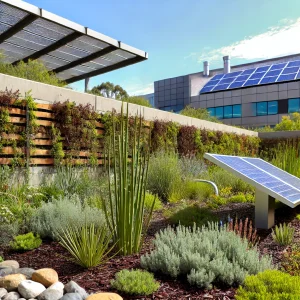
Definition and Importance of Carbon-Neutral Landscaping
Carbon-neutral landscaping refers to the practice of designing, implementing, and maintaining gardens and landscapes that balance the amount of carbon dioxide emitted with an equivalent amount sequestered or offset. The goal is to achieve a net-zero carbon footprint, reduce the environmental impact, and contribute to the fight against climate change.
This approach is crucial for several reasons:
- It helps mitigate the effects of global warming by reducing greenhouse gas emissions.
- It promotes biodiversity and healthier ecosystems.
- Businesses that adopt carbon-neutral landscaping can enhance their corporate social responsibility (CSR) profile, attracting environmentally conscious clients and customers.
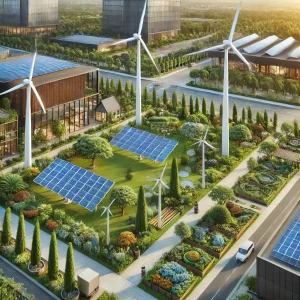
Strategies and Techniques for Achieving Zero Emissions
Achieving zero emissions in commercial gardens involves a combination of innovative strategies and techniques. Here are some key methods:
- Use of Native Plants: Native plants are well-adapted to the local climate and soil conditions, reducing the need for fertilizers, pesticides, and excessive watering. This minimizes the carbon footprint associated with these inputs.
- Organic Landscaping: Utilizing organic compost and fertilizers reduces reliance on synthetic chemicals often produced through carbon-intensive processes. Composting organic waste on-site also helps sequester carbon.
- Efficient Irrigation Systems: Drip irrigation and rainwater harvesting systems can significantly reduce water usage and the energy required to pump and treat water.
- Electric and Manual Tools: Replacing gas-powered landscaping equipment with electric or manual alternatives reduces emissions from fossil fuels.
- Renewable Energy Sources: Installing solar panels or wind turbines to power irrigation systems and garden lighting further reduces reliance on non-renewable energy sources.
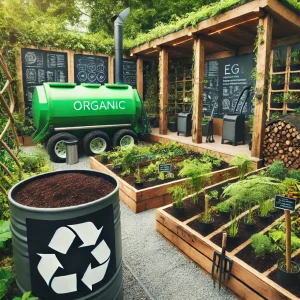
Benefits of Carbon-Neutral Landscaping
The benefits of carbon-neutral landscaping extend beyond environmental impact. These practices can save businesses money through reduced water and energy bills. Additionally, green spaces can enhance employee well-being and productivity, contributing to a positive workplace environment.
From an environmental perspective, carbon-neutral landscaping promotes healthier ecosystems by supporting local flora and fauna. It also helps improve air and soil quality, contributing to overall environmental health.
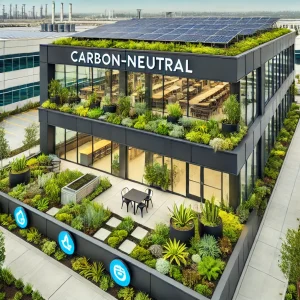
Examples of Successful Carbon-Neutral Commercial Gardens
Several gardeners and landscapers have successfully implemented carbon-neutral practices in commercial gardens. For example:
- GreenWorks Landscaping in Vancouver has transformed several corporate campuses into carbon-neutral spaces. To achieve zero emissions, they use a combination of native plants, organic compost, and solar-powered irrigation systems.
- EcoScapes in Toronto has developed carbon-neutral rooftop gardens for commercial buildings, utilizing renewable energy sources and efficient water management systems.
- Sustainable Gardens Inc. in New York has converted numerous urban landscapes into carbon-neutral zones by integrating electric landscaping tools and promoting biodiversity with native plant species.
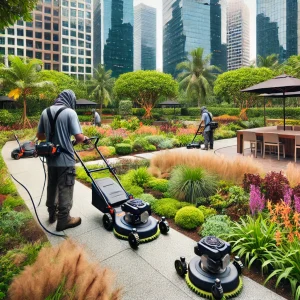
Challenges and Solutions in Implementing Carbon-Neutral Practices
Implementing carbon-neutral landscaping has its challenges. Initial costs for renewable energy systems and electric tools can be high. However, these investments often pay off in the long run through energy savings and reduced maintenance costs.
Another challenge is ongoing education and training for landscapers and maintenance staff. Workshops and certifications in sustainable practices can help address this issue, ensuring all team members have the necessary skills and knowledge.
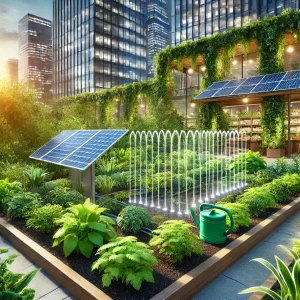
Future Trends and Innovations
The future of carbon-neutral landscaping looks promising, with several innovations on the horizon. Technology advancements, such as AI-driven irrigation systems and drone-based landscape monitoring, are set to revolutionize the industry. Additionally, the increased availability of carbon offset programs will enable businesses to balance their emissions more effectively.
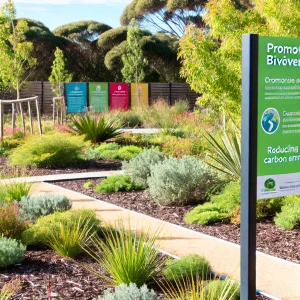
Recommendations for Products and Services
To achieve carbon-neutral landscaping, consider the following products and services:
- Electric Landscaping Equipment: Brands like Greenworks and EGO offer a range of electric mowers, trimmers, and blowers.
- Solar-Powered Irrigation Systems: Companies like Rain Bird and Orbit provide efficient solar-powered irrigation solutions.
- Native Plants and Organic Compost: Local nurseries and garden centers often have a wide selection of native plants and organic gardening products.
In conclusion, carbon-neutral landscaping represents a vital step towards sustainable commercial gardening. By adopting these practices, businesses can reduce their environmental impact, promote biodiversity, and reap economic benefits while contributing to a greener future.